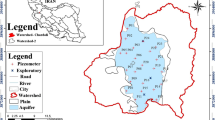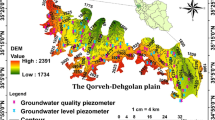Abstract
Aquifer vulnerability assessment techniques have been developed to predict which areas are more likely than others to become contaminated as a result of activities at or near the land surface. This research focuses on the evaluation of groundwater vulnerability to pollution in an urban area. Among several assessment methods, DRASTIC has been selected for this study. ArcGIS has been used to overlay and calculate different layers and obtain the vulnerability map. In order to show the importance of fuzzy algorithms in classification, both Boolean and fuzzy algorithms were used and compared. The fuzzy algorithm could recognize the areas with low and negligible vulnerability potentials whereas the Boolean model classified them as moderate. Two sensitivity tests, the map removal sensitivity analyses and single-parameter sensitivity analysis, were performed to show the importance of each parameter in the index calculation.









Similar content being viewed by others
References
Aller L, Bennet T, Lehr JH, Petty RJ, Hackett G (1987) DRASTIC: a standardized system for evaluating groundwater pollution potential using hydrogeological settings. EPA/600/2–87/035. US Environmental Protection Agency, USA
Al-Zabet T (2002) Evaluation of aquifer vulnerability to contamination potential using the DRASTIC method. Environ Geol 43:203–208
Babiker IS, Mohamed MAA, Hiyama T, Kato K (2005) A GIS-based DRASTIC model for assessing aquifer vulnerability in Kakamigahara Heights, Gifu Prefecture, Central Japan. Sci Total Environ 345:127–140
Barber C, Bates LE, Barron R, Allison H (1993) Assessment of the relative vulnerability of groundwater to pollution: a review and background paper for the conference workshop on vulnerability assessment. J Aust Geol Geophys 14:1147–1154
Chen WP, Lee CH (2003) Estimation groundwater recharge from streamflow records. J Environ Geol 44:257–265
Cox E (1999) The fuzzy systems handbook: a practitioner’s guide to building, using, and maintaining fuzzy systems. AP Professional, San Diego
Di Martino F, Sessa S, Loia V (2004) A fuzzy-based tool for modelization and analysis of the vulnerability of aquifers: a case study. Int J Approx Reason 38:99–111
Dixon B, Scott HD, Steele KF, Dixon JC (2002) Prediction of aquifer vulnerability to pesticides using fuzzy rule-based models at the regional scale. Phys Geogr 23:130–153
Hashimoto T, Stedinger JR, Loucks DP (1982) Reliability, resiliency, and vulnerability criteria for water resources system performance evaluation. Water Resour Res 18:14–20
Kasabov NK (1996) Foundations of neural networks, fuzzy systems, and knowledge engineering. MIT Press, Cambridge
Lee S, Choi S (1997) Groundwater pollution susceptibility assessment of Younggwang area using GIS technique (in Korean). J Korean Soc Groundw Environ 4:223–230
Lodwick WA, Monson W, Svoboda L (1990) Attribute error and sensitivity analysis of map operations in geographical information systems: suitability analysis. Int J Geogr Inf Syst 4:413–428
Lynch SD, Reynders AG, Schulze RE (1997) A DRASTIC approach to groundwater vulnerability in South Africa. South African J Sci 93:59–60
Merchant JW (1994) GIS-based groundwater pollution hazard assessment: a critical review of the DRASTIC model. Photogramm Eng Remote Sens 60:1117–1127
Napolitano P, Fabbri AG (1996) Single-parameter sensitivity analysis for aquifer vulnerability assessment using DRASTIC and SINTACS. IAHS Conference: HydroGIS96, Vienna, pp 559–566
Plymale CL, Angle MP (2002) Groundwater pollution potential of Fulton County, Ohio. Report No. 45. Ohio Department of Natural Resources, Water Resources Section
Silvert W (1997) Ecological impact classification with fuzzy sets. Ecol Modell 96:1–10
Wright KA, Xu Y (2000) A water balance approach to the sustainable management of groundwater in South Africa. J Water SA 26:167–170
Yuan-Yuan M, Xue-gang Z, Lian-Sheng W (2006) Fuzzy pattern recognition method for assessing groundwater vulnerability to pollution in the Zhangji area. J Zhejiang Univ 7:1917–1922
Zadeh LT (1965) Fuzzy sets. Inform. Control 8:338–353
Acknowledgments
The authors would like to thank the Research Department of the Ministry of Energy of Iran for financial support of this research.
Author information
Authors and Affiliations
Corresponding author
Rights and permissions
About this article
Cite this article
Mohammadi, K., Niknam, R. & Majd, V.J. Aquifer vulnerability assessment using GIS and fuzzy system: a case study in Tehran–Karaj aquifer, Iran. Environ Geol 58, 437–446 (2009). https://doi.org/10.1007/s00254-008-1514-7
Received:
Accepted:
Published:
Issue Date:
DOI: https://doi.org/10.1007/s00254-008-1514-7




